Related Research Articles

James Knox Polk was the 11th president of the United States, serving from 1845 to 1849. A protégé of Andrew Jackson and a member of the Democratic Party, he was an advocate of Jacksonian democracy and extending the territory of the United States. Polk led the U.S. into the Mexican–American War, and after winning the war he annexed the Republic of Texas, the Oregon Territory, and the Mexican Cession.

Presidential elections were held in the United States from November 1 to December 4, 1844. Democratic nominee James K. Polk narrowly defeated Whig Henry Clay in a close contest turning on the controversial issues of slavery and the annexation of the Republic of Texas. This is the only election in which both major party nominees served as Speaker of the House at one point, and the first in which neither candidate held elective office at the time.

The Compromise of 1850 was a package of five separate bills passed by the United States Congress in September 1850 that temporarily defused tensions between slave and free states in the years leading up to the American Civil War. Designed by Whig senator Henry Clay and Democratic senator Stephen A. Douglas, with the support of President Millard Fillmore, the compromise centered on how to handle slavery in recently acquired territories from the Mexican–American War (1846–48).
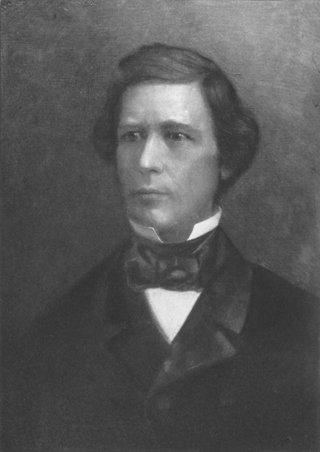
The Wilmot Proviso was an unsuccessful 1846 proposal in the United States Congress to ban slavery in territory acquired from Mexico in the Mexican–American War. The conflict over the Wilmot Proviso was one of the major events leading to the American Civil War.

George Mifflin Dallas was an American politician and diplomat who served as mayor of Philadelphia from 1828 to 1829, the 11th vice president of the United States from 1845 to 1849, and U.S. Minister to the United Kingdom from 1856 to 1861.
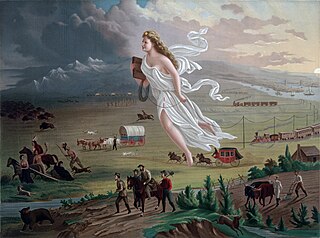
"Manifest destiny" is a phrase that represents the belief in the 19th-century United States that American settlers were destined to expand westward across North America, and that this belief was both obvious ("manifest") and certain ("destiny"). The belief is rooted in American exceptionalism and Romantic nationalism, implying the inevitable spread of the republican form of governance. It is one of the earliest expressions of American imperialism in the United States of America.

The Treaty of Guadalupe Hidalgo officially ended the Mexican–American War (1846–1848). It was signed on 2 February 1848 in the town of Guadalupe Hidalgo.

The Thornton Affair, also known as the Thornton Skirmish, Thornton's Defeat, or Rancho Carricitos, was a battle in 1846 between the military forces of the United States and Mexico 20 miles (32 km) west upriver from Zachary Taylor's camp along the Rio Grande. The much larger Mexican force defeated the Americans in the opening of hostilities, and was the primary justification for U.S. President James K. Polk's call to Congress to declare war.

The Republic of Texas was annexed into the United States and admitted to the Union as the 28th state on December 29, 1845.
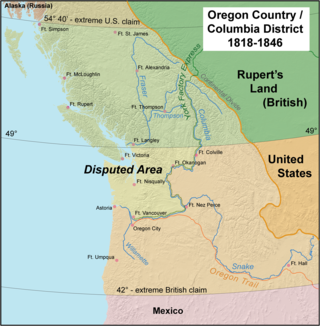
The Oregon boundary dispute or the Oregon Question was a 19th-century territorial dispute over the political division of the Pacific Northwest of North America between several nations that had competing territorial and commercial aspirations in the region.

Robert James Walker was an American lawyer, economist and politician. An active member of the Democratic Party, he served as a member of the U.S. Senate from Mississippi from 1835 until 1845, as Secretary of the Treasury from 1845 to 1849 during the administration of President James K. Polk, and briefly as Territorial Governor of Kansas in 1857. He was responsible for drafting the 1849 bill that eventually established the United States Department of the Interior.
The All of Mexico Movement, or All Mexico Movement, was a political movement to expand the United States to incorporate all of Mexico. It was a controversial aspect of Manifest Destiny that was unable to garner enough political support to encourage adoption. The Mexican-American War (1846–1848) brought the United States and Mexico into conflict over various geopolitical issues, including a desire to invade and annex much of Mexico, that resulted in victory for the United States.
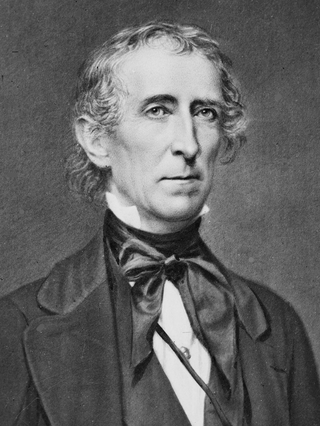
The presidency of John Tyler began on April 4, 1841, when John Tyler became the 10th President of the United States upon the death of President William Henry Harrison, and ended on March 4, 1845. He had been Vice President of the United States for only 31 days when he assumed the presidency. Tyler was the first to succeed to the office without being elected to it. To forestall constitutional uncertainty, Tyler took the presidential oath of office on April 6, assumed full presidential powers, and served out the balance of Harrison's four-year term, a precedent that would govern future extraordinary successions and eventually become codified in the Twenty-fifth Amendment. He was succeeded by James Polk of the Democratic Party.
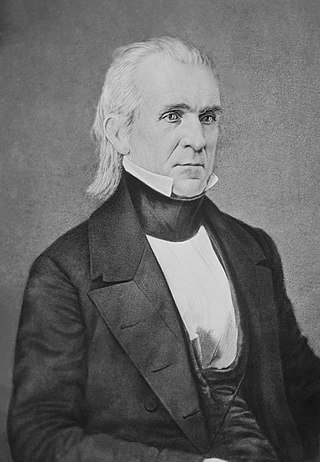
The presidency of James K. Polk began on March 4, 1845, when James K. Polk was inaugurated as the 11th President of the United States, and ended on March 4, 1849. He was a Democrat, and assumed office after defeating Whig Henry Clay in the 1844 presidential election. Polk left office after one term, fulfilling a campaign pledge he made in 1844, and he was succeeded by Whig Zachary Taylor. A close ally of Andrew Jackson, Polk's presidency reflected his adherence to the ideals of Jacksonian democracy and manifest destiny.

John Tyler was the tenth president of the United States, serving from 1841 to 1845, after briefly holding office as the tenth vice president in 1841. He was elected vice president on the 1840 Whig ticket with President William Henry Harrison, succeeding to the presidency following Harrison's death 31 days after assuming office. Tyler was a stalwart supporter and advocate of states' rights, including regarding slavery, and he adopted nationalistic policies as president only when they did not infringe on the states' powers. His unexpected rise to the presidency posed a threat to the presidential ambitions of Henry Clay and other Whig politicians and left Tyler estranged from both of the nation's major political parties at the time.
In 1845, the Republic of Texas was annexed to the United States of America, becoming the 28th U.S. state. Border disputes between the new state and Mexico, which had never recognized Texas independence and still considered the area a renegade Mexican state, led to the Mexican–American War (1846–1848). When the war concluded, Mexico relinquished its claim on Texas, as well as other regions in what is now the southwestern United States. Texas' annexation as a state that tolerated slavery had caused tension in the United States among slave states and those that did not allow slavery. The tension was partially defused with the Compromise of 1850, in which Texas ceded some of its territory to the federal government to become non-slave-owning areas but gained El Paso.

Republic of Texas–United States relations refers to the historical foreign relations between the now-defunct Republic of Texas and the United States of America. Relations started in 1836 after the Texas Revolution and ended in 1845 upon the annexation of Texas by the United States.

The history of U.S. foreign policy from 1829 to 1861 concerns the foreign policy of the United States during the presidential administrations of Andrew Jackson, Martin Van Buren, William Henry Harrison, John Tyler, James K. Polk, Zachary Taylor, Millard Fillmore, Franklin Pierce, and James Buchanan. During this era, the United States annexed the Republic of Texas, acquired the Mexican Cession by defeating Mexico in the Mexican–American War and partitioned Oregon Country with the United Kingdom of Great Britain and Ireland. The period began with the inauguration of Jackson in 1829, while the onset of the American Civil War in 1861 marked the start of the next period in U.S. foreign policy.
The 1843 State of the Union address was delivered by the 10th president of the United States John Tyler to the 27th United States Congress on December 5, 1843. In this address, President Tyler spoke of America's overall prosperity and stability, crediting "the superintendence of an overruling Providence" for guiding the nation through its many trials. Tyler's remarks emphasized the nation's peace, rising trade and commerce, and the abundance of agricultural production in 1843, which together had contributed to economic revival following the financial instability of prior years.
The 1848 State of the Union address was delivered by James K. Polk, the 11th president of the United States, to the 30th United States Congress on December 5, 1848. This address highlighted Polk’s vision for America following the recent territorial gains from the Mexican-American War and addressed both domestic policies and international relations in a rapidly expanding nation.
References
- ↑ "Joint Meetings, Joint Sessions, & Inaugurations | US House of Representatives: History, Art & Archives". history.house.gov. Retrieved 4 November 2024.
- 1 2 3 4 "James K. Polk - State of the Union Address -- 1845". The American Presidency Project. Retrieved 19 October 2024.